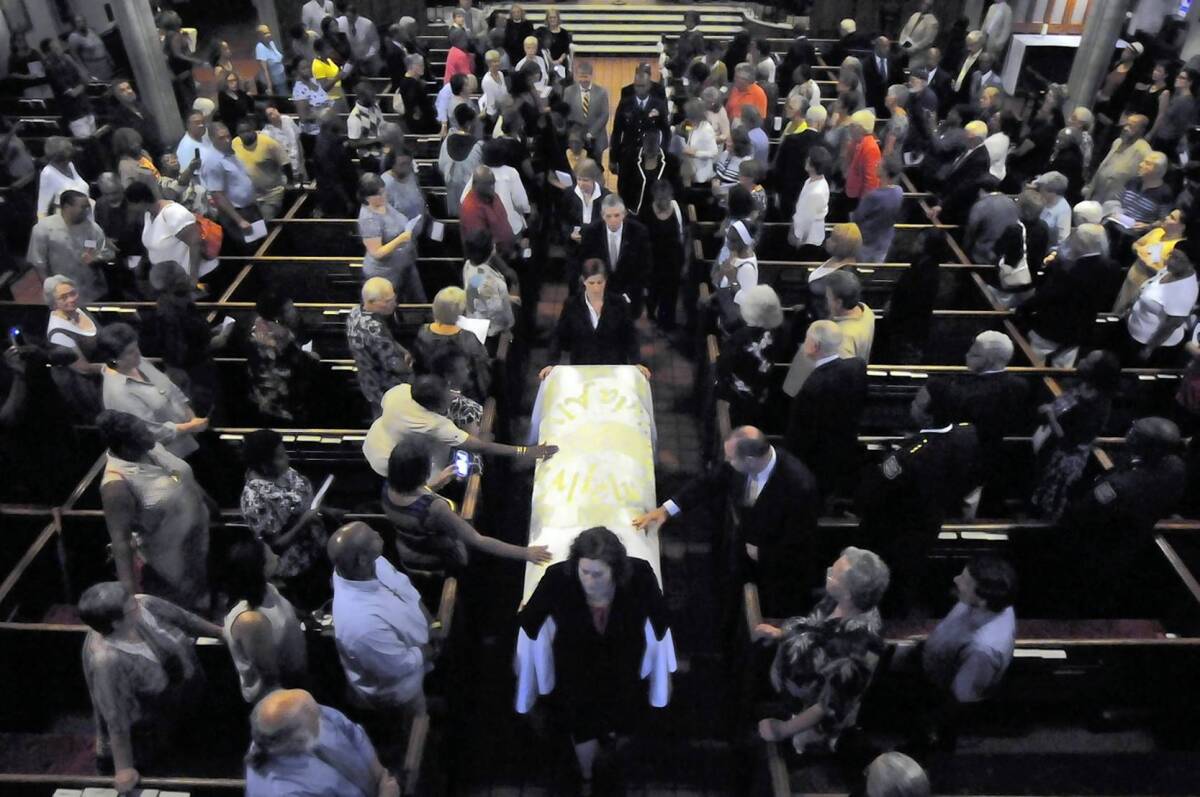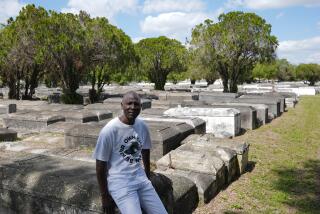A slave whose bones helped train doctors gets a proper burial

- Share via
In life and in death, the man known as Fortune was treated as nothing more than a thing owned by others.
Fortune was a slave in Waterbury in east-central Connecticut, purchased by a doctor and bonesetter, Preserved Porter. When Fortune died in 1798, Porter flayed Fortune’s corpse and boiled the bones. The bones were used for more than 100 years by Porter’s descendants to learn anatomy and become doctors.
In 1933, one of Porter’s descendants donated Fortune’s bones to the Mattatuck Museum in town. Fortune’s skeleton was propped up for display there for more than 30 years. In the early 1970s, after the peak of the civil rights movement, the slave’s skeleton was taken down, boxed and put in storage. It remained there for more than 25 years.
Last week, Fortune got something of his own: a respectful burial.
“Fortune was mistreated, even after he died. ... The museum did not do any research on who he really was, how he died, what he did. He was just there as an attraction,” said Marie Galbraith, director of the Mattatuck from 2001 to 2012. “Now the research has been done. We did as much as we can. We want to give Fortune his personhood.”
In 1996, Mattatuck initiated the Fortune Project to discover the story of the man who became the museum’s skeleton. The effort was an offshoot of another project started years earlier by the Mattatuck’s African American History Project Committee to study the history of blacks in the city of about 110,000 residents. Maxine Watts, former head of the Waterbury branch of the National Assn. for the Advancement of Colored People, led the committee.
“We decided we were going to have to approach people 80 years old and over and ask them to do oral history with us about growing up in Waterbury,” Watts said. “We were hoping to find the oldest people we could and talk to them before they were gone.”
That project made headlines in the local press. A Waterbury attorney, Gary Broder, read the stories and wrote to Watts, asking her to look into “Larry the skeleton,” a former Mattatuck exhibit known to have been a slave.
“I asked Marie, ‘Whatever happened to that skeleton?’ She said, ‘It’s still here, let’s bring him up,’” Watts said. “We were looking for the oldest African American in town, and all the time he was right here.”
In his collection of historical Waterbury postcards, Broder owns a picture postcard of “Larry the skeleton.” It shows the skeleton with “Larry” scrawled across the forehead, flanked by a shovel and a pitchfork. The postmark is unclear, but the postcard dates to between 1958 and 1963, when postcard postage was 3 cents.
Broder recalls seeing the skeleton when he was a child. “I was in grammar school. I saw it and thought, ‘There’s a skeleton, that’s pretty cool,’” he said. “As a grammar-school-age kid, I didn’t have a real concept of what it was. It was a skeleton. Every kid knows what a skeleton is. We think of it from Halloween. I certainly didn’t have a sense of it as a person.”
Launching off from Broder’s postcard, the Fortune Project consulted an 1896 book, “The Town and City of Waterbury, Connecticut, from the Aboriginal Period to the Year Eighteen Hundred and Ninety-Five,” edited by Joseph Anderson. The book called the slave Larry and said he drowned in 1798. It referred to Porter’s use of the slave’s bones as “economical.”
In historical records, it was noted that a slave named Fortune belonging to Preserved Porter was baptized in 1797. The estate inventory of Porter, executed by his two sons, indicated that Fortune had a wife, Dinah, and four children, sons Jacob and Africa and daughters Mira and Roxa.
The bones were donated to the Mattatuck by Sally Porter Law McGlannan after a team of workers found them while renovating an old building. Further research indicated that generations of Porters had used the bones not just as teaching tools but also as toys.
In solemn ceremonies Thursday, hundreds gathered to honor the memory of a man who, in life and death, was treated like a possession. Fortune’s bones lay in state for five hours at the state Capitol in Hartford. “Even after death, he did not get the respect he should have as a man ... as a human being,” Lt. Gov. Nancy Wyman said. “This state is welcoming him now. ... Mr. Fortune, you are somebody [who] will not be forgotten.”
The casket was taken that afternoon to St. John’s Episcopal Church on the Green, the Waterbury parish in which Fortune was baptized. Eight pallbearers carried the simple, dark wood casket into the church, where it was draped in satin and taken into the high-ceilinged, arched sanctuary.
Amy Welin, rector of St. John’s, led the service attended by a racially mixed group of more than 300 people. The fate of Fortune’s family is not known, but Welin said members of the Union of Black Episcopalians and the African American History Project Committee, the group that researched Fortune’s background, “stand in as his family.”
“By our common humanity, we’re his descendants,” said Welin, who is white.
Before the burial, several members of the local clergy also spoke. “Human beings, regardless of color, race, gender, sexual orientation or ethnicity, are all God’s children created in God’s image,” said the Rev. Calbert Brantley of Zion Baptist Church.
Two clergy members quoted Ezekiel 37, in which God asked Ezekiel, “Can these bones live?”
Winifred Ward of Grace Baptist Church responded: “I believe Mr. Fortune’s bones can live if we allow ourselves to keep telling the story.”
More to Read
Sign up for Essential California
The most important California stories and recommendations in your inbox every morning.
You may occasionally receive promotional content from the Los Angeles Times.













